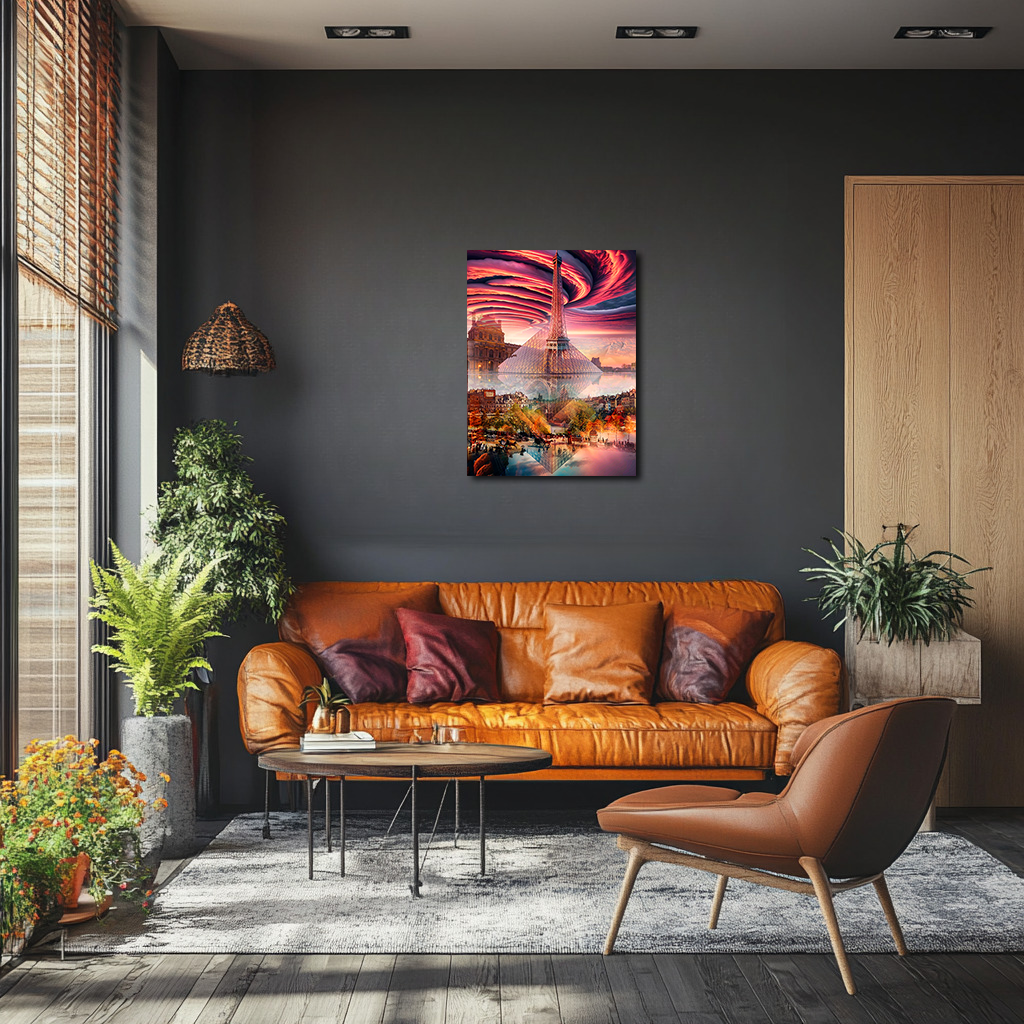Paris Refracted: The Louvre Beneath a Swirl of Time
Paris Refracted: The Louvre Beneath a Swirl of Time transforms Monet’s 1867 Quai du Louvre into a conceptual dreamscape where the Eiffel Tower rises through spiraling skies and mirrored pyramids float above a refracted city. Blending the elegance of 19th-century Paris with surreal layers of light, memory, and geometry, this piece reimagines the City of Light as both reflection and ascent—a place suspended between stillness and vision.
Please see Below for Details…
Hotline Order:
Mon - Fri: 07AM - 06PM
404-872-4663
Claude Monet’s Quai du Louvre , painted in 1867, captures the poetic stillness of a Parisian afternoon—a quiet study of light touching rooftops, trees shifting with early autumn air, and figures fading gently into the rhythm of the city. In this conceptual collage reinterpretation, titled Paris Refracted: The Louvre Beneath a Swirl of Time , the familiar elegance of 19th-century Paris is unmoored and reconstructed in a prism of temporal distortion, architectural reverie, and chromatic wonder. What begins as a walk along the Seine becomes an ascension into a dream where sky, steel, and stone converge in surreal conversation.
The original view of the Quai remains nestled near the base of the composition—horse-drawn carriages pass by chestnut trees, facades glow with sunlit nostalgia, and life unfolds with the calm pulse of a city immersed in itself. Above, however, the Eiffel Tower rises—not as a structure of steel, but as an anchor of vision, stretching upward through time and space, piercing a swirling sky that moves with the intensity of an emotion made visible.
The sky, once a pale atmospheric wash in Monet’s hand, becomes a vortex of crimson spirals, echoing galaxies, tempests, and the movement of memory. These clouds are not clouds—they are thoughts, turning and expanding, each one echoing the drama of creation and collapse. The Eiffel Tower becomes both observer and axis, its reflection multiplied in crystalline pyramids that seem to rise from the Seine like inverted temples of light.
Embedded in the upper left, the Louvre looms with golden reverence, a citadel of art and memory, while fragments of other cityscapes dissolve into its surroundings—Rome, perhaps, or Cairo, softly hinted through texture and tone. A pyramid of glass—part fantasy, part truth—emerges beneath the Eiffel Tower, creating a mirrored geometry that reflects not just the structures, but the time they carry. The city becomes a kaleidoscope, folding layers of past, present, and imagined future into one evolving whole.
Color in this piece acts as both narrative and structure. Warm ambers and soft autumnal hues ground the lower half in the familiar palette of Monet’s Paris, while above, electric magentas, saturated oranges, and surreal lavenders spiral across the sky with dreamlike intensity. Light and shadow flicker with intention—highlighting spires, diffusing façades, painting the edges of possibility.
As the artist, I sought not to modernize Monet’s vision, but to allow it to travel—to rise beyond its own moment and become a meditation on cities as dreams. The Eiffel Tower, which Monet never painted, here rises as a monument to all that Paris became, while the original rhythm of Quai du Louvre grounds it in a specific, sacred stillness. This juxtaposition invites reflection on how a city holds both silence and spectacle, memory and transformation.
The pyramidal forms, both of glass and reflection, act as containers of time. They gather fragments of architecture, of light, of the turning sky, and focus them inward. The Seine does not flow in this piece—it mirrors. It contains. It refracts the histories written on its banks and offers them back as myth.
Add your review
Your email address will not be published. Required fields are marked *
Please login to write review!
Looks like there are no reviews yet.








